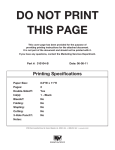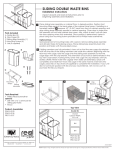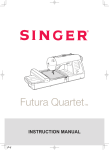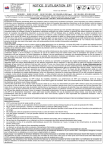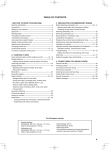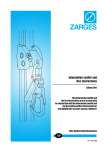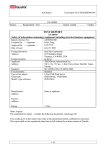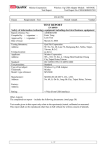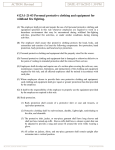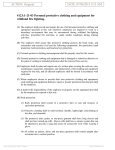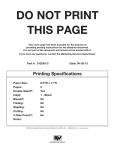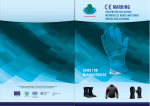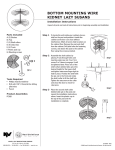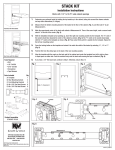Download 44-5530 - Weldas
Transcript
www.tuv.com Prüfbericht - Nr.: 21190268 001 Test Report No.: 566-12-1060 Seite 2 von 11 Page 2 of 11 Verwendete Meßgeräte/Prüfmittel / Equipmentlist Messung / Measuring Gerätenummer/Ident.-Nummer Barcode-Nummer Equipment number nächste Kalibrierung/Überwachung next calibration/ surveillance Clothing design / Sizes 7440161 01/2014 Flame spread 7440106 01/2013 Tensile strength 7440191 03/2013 Tear strength 7440191 03/2013 Seam strength 7440191 03/2013 Fat content of leather TRLP chemical laboratory Cologne Report-no. AZ 123199 Azo-colorants TRPL chemical laboratory Cologne Report-no. AZ 123197 Pentachlorophenol TRPL chemical laboratory Cologne Report-no. AZ 123197 pH-value TRPL chemical laboratory Cologne Report-no. AZ 123197 Chromium-VI-content of leather TRPL chemical laboratory Cologne Report-no. AZ 123197 Radiant Heat Impact of splatter 7440174 12/2012 accredited subcontractor STFI report-no. 2112 1794 Electric resistance 7440140 09/2013 Test results of accredited laboratories of competent subcontractor are marked with /*. Rev. 4 2012-03 02 / approved: D. Knape www.tuv.com Prüfbericht - Nr.: 21190268 001 Test Report No.: 566-12-1060 Seite 3 von 11 Page 3 of 11 Artikelbeschreibung / Article description/Picture Grain Golden Brown leather jacket Art. 44-5530 Größen/ sizes: L – XXXL EN ISO 11611:2007 Class 2 Grain Golden Brown overall (bib and brace) Art. 44-5600 Größen/ sizes: L – XXXL EN ISO 11611:2007 Class 2 Rev. 4 2012-03 02 / approved: D. Knape www.tuv.com Prüfbericht - Nr.: 21190268 001 Test Report No.: 566-12-1060 Seite 4 von 11 Page 4 of 11 Test results Design in according to ISO 11611 Parameter General Protective clothing Design Wearing comfort acc. to ISO 11611 section 4.1 ISO 13688 (EN 340) section 4.1.1 EN 340/ 4.3 EN 340/ 4.4 ISO 13688 Rev. 4 2012-03 02 / approved: D. Knape Requirement General requirements which are not specifically covered in this International Standard shall be in accordance with ISO 13688. Welders' protective clothing shall be designed without electrical conduction from the outside to the inside, e.g. by metal fasteners. Conformity shall be checked by visual inspection. Welders' protective suits shall completely cover the upper and lower torso, neck, arms and legs. Suits shall consist of: - a single garment, e.g. an overall or boiler suit; - or a two-piece garment, consisting of a jacket and a pair of trousers. The jacket of a two-piece suit shall provide a minimum overlap of 20 cm between the jacket and the top of the trousers. This minimum overlap shall be maintained in all positions and in movements encountered during welding. Conformity shall be checked by visual inspection and practical testing, such as physical measurement of the overlap in all positions and movements normally encountered during welding. Correct put on and fit All body parts are protected even in movement Protective unit even with other protective equipment items Level of comfort shall be consistent. - with the level of protection against hazard which is provided - the ambient conditions - the level of the users activity - the anticipated duration of the use Protective clothing shall not: - have rough, sharp or hard surfaces that irritate or injure the user - be so tight that blood flow is restricted - be so loose and heavy so that it interferes with movements - where permissible use of materials with low water vapour resistance and/ or high airpermeability Test result given P Remark F N/A N/T P P given given P given P given P given P www.tuv.com Prüfbericht - Nr.: 21190268 001 Test Report No.: 566-12-1060 Parameter Additional protective clothing Sizes acc. to ISO 11611 section 4.1.2 section 4.2 ISO 13688 (EN 340) Requirement Test result Welder’s protective garments may be designed to provide extra protection for specific areas of the body when worn in addition to a suit, e.g. neck curtain, hoods, sleeves, apron and gaiters. Performance testing of partial protective garments shall be carried out on the complete assembly. Additional protective clothing such as hoods, sleeves, apron and gaiters shall cover the intended areas if worn with a suit of appropriate size and shall also meet the requirements of this International Standard. P --- Remark F N/A N/T N/A minimum information: garment jacket, coat, vest trousers overall apron protective equipment control measures chest / height waist / height chest / height waist / height or chest / height waist/ chest/ height, weight or waist- houlderlenght additional the pictogram is to use Rev. 4 2012-03 02 / approved: D. Knape Seite 5 von 11 Page 5 of 11 jacket size chest measurement height M L 112 81 XL 124 86 XXL 136 91 XXXL 148 96 XXXXL trousers size waist measurement M L 92 XL 95 XXL 103 XXXL 105 XXXXL height 100 104 106 112 P www.tuv.com Prüfbericht - Nr.: 21190268 001 Test Report No.: 566-12-1060 Parameter Pockets acc. to ISO 11611 section 4.3 Closures and seams section 4.4 Rev. 4 2012-03 02 / approved: D. Knape Requirement Where garments are constructed with pockets, the pockets shall be constructed to the following design: a) pockets with external openings given shall be made of material(s) conforming to 6.7 and 6.8. b) external opening pockets including given pass through openings shall be flapped except for: − side pockets below the waist which do not extend more than 10° forward of the side seam − a single rule pocket with an opening not greater than 75 mm placed behind the side seam on one or both legs and measured flat given c) all flaps shall be stitched down or capable of fastening the pocket closed. They shall be 20 mm wider than the opening (10 mm on each side) to prevent the flap from being tucked into the pocket. Conformity shall be checked by visual inspection and physical measurement. Closures shall be designed with a protective cover flap on the outside of given the garment. The maximum distance between buttonholes shall be 150 mm. If zippers are used, the slide fastener shall be designed to lock when completely closed. Cuffs may be provided with closures to reduce their width. The closure and any fold which it creates shall be on the underside of the cuff. Cuffs shall not have turn-ups. Neck openings shall be provided with closures. Trousers or one-piece suits shall not have turn-ups. They may have side slits which shall have a means of closure and the slit and closure shall be covered. Overlapping seams on the outside of the garment shall be downward facing and overstitched. Seite 6 von 11 Page 6 of 11 Test result P Remark F N/A N/T P P www.tuv.com Prüfbericht - Nr.: 21190268 001 Test Report No.: 566-12-1060 Seite 7 von 11 Page 7 of 11 General safety standard according to ISO 11611 Parameter Pre-treatment acc. to ISO 11611 section 5.2 Requirement Leather shall not be pre-treated. Test result P --- Remark F N/A N/T N/A Cleaning: Before each test the cleaning of the protective clothing shall be in line with the manufacturer’s instructions, on the basis of standardized processes. If the number of cleaning cycles is not specified, five cleaning cycles shall be performed. Ageing: in acc. to the maximum number of cleaning procedures indicated by the manufacturer. Tensile strength section 6.1 Woven outer textiles: ISO 13934-1 minimum 400 N or ISO 3376 Leather: minimum 80 N Tensile strength [N] leather Direction I: 162,5 133,6 Direction II: 142,8 131,5 P 182,9 248,1 Tensile strength [N] band yellow Direction I: 871,5 795,1 741,0 P P Tear strength section 6.2 Woven outer textiles / leather : ISO 13937-2 minimum 20 N. or ISO 3377-1 Tear strength [N] leather: Direction I: 66,1 83,6 Direction II: 73,3 65,1 Burst strength of knitted materials section 6.3 Knitted outer material ISO 13938-1 minimum 200 kPa --- Seam strength section 6.4 Textiles: at least 225 N ISO 13935-2 Leather at least 110N Seam strength [N] Leather mixed samples of seams 796,4 670,7 733,8 379,1 723,4 Dimensional change of section 6.5, EN 340/ 5; textile materials ISO 5077 Requirements for leather section 6.6 ISO 4048 Rev. 4 2012-03 02 / approved: D. Knape Woven textile materials ±3 Knitted textile materials ±5% Fat content Not more than 15 %. --- Leather yellow 7 % N/A P N/A P www.tuv.com Prüfbericht - Nr.: 21190268 001 Test Report No.: 566-12-1060 Parameter Flame spread Impact of splatter Heat transfer (radiation) Electrical resistance Innocuousness Possible harmful effect pH-value Content of Cr(VI) Release of Nickel Colour fastness to perspiration Azo-dyestuff acc. to ISO 11611 section 6.7 ISO 15025 procedure A or procedure B section 6.8 ISO 9150 section. 6.9 ISO 6942 section 6.10 EN 1149-2 Seite 8 von 11 Page 8 of 11 Requirement Test result Flame spread Leather: Each material or material assembly After flame time < 2 s and each type of seam used in After glow time < 2 s welders’ protective clothing shall be No flaming to side or top tested, using either Procedure A (code letter A1), or Procedure B (code letter No hole formation A2), or both, in accordance with the No molten debris existent risk during the foreseen use. Following requirements shall be meet: Flame spread Band yellow: After flame time < 2 s a) no specimen shall give flaming to After glow time < 2 s the top or either side edge; No flaming to side or top b) no specimen shall give hole No hole formation formation No molten debris c) no specimen shall give flaming or molten debris; d) the mean value of afterflame time shall be < 2 s; e) the mean value of afterglow time shall be < 2 s. each material or material garment assemblies shall require − at least 15 drops of molten metal to raise the temperature behind the test specimen by 40 K for Class 1 − 25 drops of molten metal to raise the temperature behind the test specimen by 40 K for Class 2 Material which ignites does not fulfil this test at a heat flux density of 20 kW/m2, the radiant heat transfer index (RHTI for 24 °C) each material or material garment assemblies shall be: - for Class 1: RHTI 24 W 7 s - for Class 2: RHTI 24 W 16 s > 105 Ω section 6.11 section. 6.11.1 No component of the clothing shall be known to produce any harmful effect on the wearer. This shall be verified by checking technical safety sheets of the individual materials and components. leather yellow > 35 > 35 > 35 > 35 > 35 Amount of drops Mean value RHTI 24: 29 s mean value: 30 s 31 s P Remark F N/A N/T P P P Class 2 P Class 2 Class 2 at (20 ± 2)°C and relative humidity of (85 ± 5)% 1,0 x 105 1,7 x 105 1,7 x 105 1,6 x 105 1,4 x 105 /* Additional: Pentachlorophenol customer requirement Split leather yellow < 0,1 mg/ kg (limit value acc. to restriction ordinance on chemicals: 5 mg/ kg) P P section 6.11.2, between 3,5 and 9,5 EN 340/ 4.2 c, ISO 3071 or ISO 4045 section 6.11.3 shall be less than the detection limit EN 340/ 4.2 a, ISO 17075 EN 340/ 4.2 b < 0,5 µg/cm² per week --- N/A EN 340/ 4.2 d minimum level 4 at grey scale --- N/A EN 340/ 4.2 e not detectable (< 30 mg/kg) Rev. 4 2012-03 02 / approved: D. Knape /* Leather yellow 3,8 P /* Leather yellow < 3 mg/kg P /* Not detectable ( < 5 mg/kg) P www.tuv.com Prüfbericht - Nr.: 21190268 001 Test Report No.: 566-12-1060 Seite 9 von 11 Page 9 of 11 Marking according to ISO 11611 Parameter Marking acc. to ISO 11611 section 7 General EN 340/ 7.1 Details EN 340/ 7.2 Requirement Welders’ protective clothing, for which compliance with this International Standard is claimed, shall be marked - official language for the country of destination - attached at the article or at the label - visible and readable - resistance against suitable care procedures Test result given given P Remark F N/A N/T P P given given given and with the following information: P - name, trade name or different version for the identification of the manufacturer - title of the product type, code - size marking a) classification: Class 1: the number of this International Standard (ISO 11611) followed by the pictogram and the indication “Class 1” and the indication “A1” or “A2” or “A1 A2” as appropriate Class 2: the number of this International Standard (ISO 11611) followed by the pictogram and the indication “Class 2” and the indication “A1” or “A2” or “A1 A2” as appropriate where garments contain parts of both classes, these shall be identified as shown above with their classification; any additional protective clothing used shall be identified as shown above with their classification Rev. 4 2012-03 02 / approved: D. Knape Weldas Europe B.V 44-5530, 44-5600 L – XXXL Class 2 / A1 N/A b) If the garment is intended for a single use only, the information: “For single use only” N/A c) instructions for cleaning shall be marked (e.g. on a label) given in user manual - Pictograms and performance levels Given P www.tuv.com Prüfbericht - Nr.: 21190268 001 Test Report No.: 566-12-1060 Seite 10 von 11 Page 10 of 11 Information according to ISO 11611 acc. to parameter ISO 11611 Information supplied by section 8 the manufacturer EN 340 general section 8.1 Intended use section 8.2 Rev. 4 2012-03 02 / approved: D. Knape requirement test result P F note N/A Welders’ protective clothing shall be given delivered to the consumer with instructions for use. The manufacturer shall give as much information as possible on known factors of durability, especially on durability to cleaning. In the case that applying a finish can restore the protective properties, the maximum number of cleaning cycles before re-application of the finish shall be clearly indicated in the information notice. P At least the following basic information shall be provided: a) any guidance on the appropriate choice of class of welders’ protective clothing, (see Annexes A and B); b) any identified hazards against which the clothing is intended to protect (e.g. flames, molten metal spatter, radiant heat and short term, accidental electrical contact); c) a warning that for operational reasons not all welding voltage carrying parts of arc welding installations can be protected against direct contact; d) for protective clothing, a warning that additional partial body protection may be required, e.g. for welding overhead; e) a warning that the garment is only intended to protect against brief inadvertent contact with live parts of an arc welding circuit, and that additional electrical insulation layers will be required where there is an increased risk of electric shock; garments meeting the requirements of 6.10 are designed to provide protection against short term, accidental contact with live electric conductors at voltages up to approximately 100 V d.c.; f) aprons should cover the front body of the user at least from side seam to side seam; g) using additional partial protective garments, the basic garment shall meet at least Class 1 P given given given given given given given N/T www.tuv.com Prüfbericht - Nr.: 21190268 001 Test Report No.: 566-12-1060 Seite 11 von 11 Page 11 of 11 Information according to ISO 11611 Parameter Improper use acc. to ISO 11611 section 8.3 Requirement Test result Attention shall be drawn to the hazards of improper use. P Remark F N/A N/T P given a) The level of protection against flame will be reduced if the welders’ protective clothing is contaminated with flammable materials. b) An increase in the oxygen content of the air will reduce considerably the protection of the welders’ protective clothing against flame. Care should be taken when welding in confined spaces, e.g. if it is possible that the atmosphere may become enriched with oxygen. c) The electrical insulation provided by clothing will be reduced when the clothing is wet, dirty or soaked with sweat. d) For two-piece protective clothing, a warning that both items shall be worn together to provide the specified level of protection. e) For additional body protection, a warning that the garment is intended for use in addition to protective clothing providing protection against welding hazards. f) Warnings, regarding other limitations of a garment, as identified by the manufacturer. Care and maintenance section 8.4 Rev. 4 2012-03 02 / approved: D. Knape given given given given given Instructions shall be given to advise given the user on cleaning procedures, the maximum number of cleaning cycles, maintenance, inspection and repair of the garment where practical. Manufacturers shall include the information that welder's protective clothing be cleaned regularly in accordance with the manufacturer’s recommendations. After cleaning, the clothing should be inspected. P











